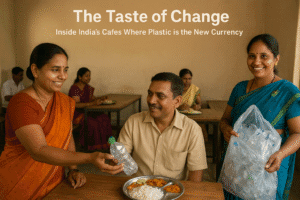The Taste of Change: Inside India’s Cafes Where Plastic is the New Currency
In Ambikapur, India, a revolutionary “Garbage Cafe” tackles hunger and pollution by allowing patrons to pay for meals with plastic waste. This ingenious exchange provides a vital lifeline for vulnerable communities, turning discarded bottles and wrappers into nutritious food. The initiative is a key part of the city’s acclaimed “zero landfill” model, which has dramatically reduced plastic pollution. Beyond a meal, it fosters dignity and environmental awareness, empowering residents to clean their streets.
While similar projects are spreading, experts caution that such local solutions are a powerful beginning but not a complete fix for the global plastic crisis. Ultimately, the cafe stands as a profound symbol of grassroots ingenuity, proving that value and compassion can be found in the most unexpected places.

The Taste of Change: Inside India’s Cafes Where Plastic is the New Currency
The air is thick with the warm, comforting scent of frying samosas and spices. Inside, the clatter of steel plates and the murmur of conversation create a familiar, welcoming atmosphere. But this is no ordinary cafe. The currency here isn’t cash or credit; it’s crumpled water bottles, discarded food wrappers, and worn-out carrier bags. Welcome to the Garbage Cafe, where a kilogram of plastic waste buys a hot, hearty meal.
This innovative concept, born in the city of Ambikapur in central India, is tackling two of society’s most persistent problems—hunger and plastic pollution—with a single, elegant solution. It’s a model that’s spreading, offering a glimpse into how grassroots ingenuity can create tangible change.
A Simple Exchange with Profound Impact
The principle is straightforward. As explained by Vinod Kumar Patel, who manages the Ambikapur cafe, the exchange rate is clear: one kilogram (2.2 lbs) of plastic earns a full meal of rice, two curries, dal, roti, salad, and pickles. A half-kilo is enough for a breakfast of samosas or vada pav.
For people like Rashmi Mondal, a local who has scoured the streets for plastic for years, this exchange is transformative. Previously, she might have earned a meager 10 rupees (about $0.12) for that same kilogram from a scrap dealer—a pittance that made survival a daily struggle.
“Now, I can get food for my family in exchange for the plastic I collect,” she says. “It makes all the difference in our lives.”
This human impact is the cafe’s core mission. It draws in those from underprivileged backgrounds, offering dignity along with sustenance. “If food is available in place of plastic, we’re not only helping to fill empty stomachs but also contributing to cleaning up the environment,” notes Sharada Singh Patel, a long-time employee.
More Than a Meal: The Ripple Effect on a City
While feeding dozens of people daily is a success in itself, the Garbage Cafe is just one piece of a much larger, ambitious puzzle. Ambikapur has earned a reputation as one of India’s cleanest cities through a revolutionary “zero landfill” model.
The plastic collected at the cafe doesn’t just disappear. It enters a sophisticated, decentralized waste management system. It’s sent to specialized local collection centers, where it’s sorted into over 60 categories by a workforce of 480 women, affectionately known as swachhata didis (cleanliness sisters). Their door-to-door collection and meticulous sorting have made the “Ambikapur Model” famous across the state.
The collected plastic is recycled into granules for road construction or sold, generating revenue for the city. This system has drastically reduced the plastic sent to landfill from 5.4 tonnes per year in 2019 to just two tonnes in 2024. The cafe itself has collected over 23 tonnes of plastic since its inception—waste that might have otherwise choked streets and drains.
A Growing Movement, But Not Without Challenges
Inspired by Ambikapur’s success, the concept has sprouted across India:
- In Siliguri and Mulugu, similar schemes trade plastic for meals or rice.
- In Mysuru, state-funded canteens now accept plastic as payment.
- In Uttar Pradesh, a campaign provides sanitary pads to women in exchange for waste.
Internationally, communities in Cambodia around the Tonle Sap Lake are adopting the model, swapping plastic for rice.
However, the path isn’t always smooth. A similar initiative in Delhi struggled, reportedly hampered by a lack of public awareness, poor waste segregation habits, and insufficient recycling infrastructure. This highlights a key insight: for such a model to thrive, it needs more than just a good idea; it requires a supportive ecosystem and a community that is both aware and engaged.
The Deeper Truth: A Beginning, Not an End
Experts like Minal Pathak, a professor researching urban climate mitigation, applaud these initiatives for raising awareness and providing immediate relief. Yet, she offers a crucial perspective: garbage cafes are a powerful “quick fix,” but they are not a silver bullet.
“They teach people about the problem and show that local solutions can have an impact,” she says. However, they don’t address the root causes: the relentless overproduction of plastic, the prevalence of non-recyclable materials, and the lack of large-scale systemic change.
The true genius of the Garbage Cafe may not be in the tonnes of plastic it collects, but in the mindset it fosters. It makes the abstract problem of pollution tangible, connecting it directly to community well-being. It’s a potent symbol that demonstrates our waste has value and that solutions can be both practical and compassionate.
It’s a powerful beginning, proving that sometimes, the most profound changes start with a simple meal, paid for with the trash beneath our feet.
You must be logged in to post a comment.